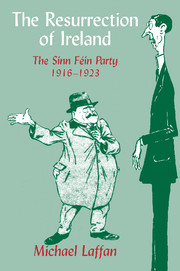Book contents
- Frontmatter
- Contents
- List of illustrations
- List of figures and tables
- Preface
- Note on the text
- List of abbreviations
- PROLOGUE: BEFORE THE EASTER RISING
- THE IRISH REVOLUTION, 1916–1923
- 2 Rebellion and hibernation, 1916
- 3 Organizers and converts, 1917
- 4 Reverses and victory, 1918
- 5 The party: structures and members
- 6 Policy: beliefs and attitudes
- 7 War and repression, 1919–1921
- 8 Ministers and bureaucrats, 1919–1921
- 9 The treaty and the split, 1921–1922
- 10 The Pact election and the Civil War, 1922–1923
- EPILOGUE: AFTER THE CIVIL WAR
- Select bibliography
- Index
7 - War and repression, 1919–1921
Published online by Cambridge University Press: 05 March 2012
- Frontmatter
- Contents
- List of illustrations
- List of figures and tables
- Preface
- Note on the text
- List of abbreviations
- PROLOGUE: BEFORE THE EASTER RISING
- THE IRISH REVOLUTION, 1916–1923
- 2 Rebellion and hibernation, 1916
- 3 Organizers and converts, 1917
- 4 Reverses and victory, 1918
- 5 The party: structures and members
- 6 Policy: beliefs and attitudes
- 7 War and repression, 1919–1921
- 8 Ministers and bureaucrats, 1919–1921
- 9 The treaty and the split, 1921–1922
- 10 The Pact election and the Civil War, 1922–1923
- EPILOGUE: AFTER THE CIVIL WAR
- Select bibliography
- Index
Summary
Sinn Féin's achievements of the previous two years reached their apogee on 21 January 1919 with the formal opening of the first Dáil Éireann, or Irish parliament. The Act of Union was formally repudiated, the Irish republic which had been proclaimed in arms in 1916 was now confirmed by a democratically elected assembly, and (at least in theory) the newly elected MPs could proceed to legislate for their country. The Sinn Féin deputies could choose a government and begin to implement Griffith's long-term programme.
While these events were taking place in the Mansion House, a group of nine Volunteers waited in ambush by the side of a road at Soloheadbeg in Tipperary. They then seized a cart laden with gelignite, and in the course of their action they killed the two RIC constables who guarded the consignment. The operation was on a small scale and it was bungled; the gelignite was taken, but the detonators were left behind. The killing of the policemen may have been unintentional, and may have been another sign of an operation which had gone wrong. However, this incident came to be seen in retrospect as the opening round in the Anglo-Irish War, or the War of Independence, which would last until the truce of July 1921. The achievements of the triumphant Sinn Féin party and of the newly elected Dáil would be overshadowed by those of the IRA, as the Volunteers were now more often called.
- Type
- Chapter
- Information
- The Resurrection of IrelandThe Sinn Féin Party, 1916–1923, pp. 266 - 303Publisher: Cambridge University PressPrint publication year: 1999



